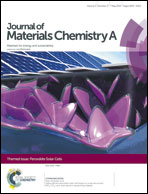A combined single crystal neutron/X-ray diffraction and solid-state nuclear magnetic resonance study of the hybrid perovskites CH3NH3PbX3 (X = I, Br and Cl)†
Abstract
The 1H and 13C NMR spectra in methylammonium lead halide perovskites, CH3NH3PbX3 (X = I, Br and Cl) show that the CH3NH3+ units undergo dynamic reorientation, as the organic component tumbles in the perovskite cage. In addition, the differences in the anomalously long relaxation times of the protons associated with the CH3 and not the NH3 groups indicate that only the amine end of the CH3NH3+ group is interacting with the inorganic network. Using this information, we have refined some single crystal X-ray and neutron diffraction data to probe their unusual structures in more detail. Furthermore, impedance spectroscopy has been used to monitor the high-temperature phase transition of CH3NH3PbI3, which confirms a significant increase in conductivity, when it is in its high temperature and higher symmetry structural regime. The optical band-gaps of each halide perovskite were determined using UV-visible spectroscopy and are consistent with previous reports.

- This article is part of the themed collection: Perovskite Solar Cells

 Please wait while we load your content...
Please wait while we load your content...